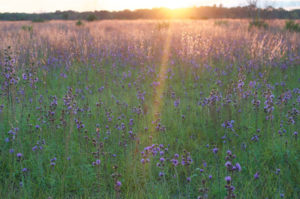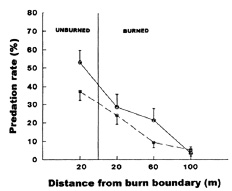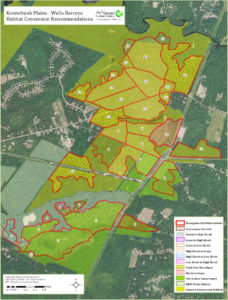Prescribed Burning at Kennebunk Plains

Figure 1. Purple flowers of northern blazing star (Liatris novae-angliae) population. Photo credit: Robert Wernerehl.
Kennebunk Plains is located in a large continuous barren area that consists of more than 405 hectares (1,000 acres) of diverse sandplain communities including sandplain grasslands, pitch pine-heath barrens, pitch pine-scrub oak barrens, and red maple alluvial swamp forest (Fig. 1). This area has been protected since 1989 with funding from the Land for Maine’s Future program. The property is located in the towns of Kennebunk and Sanford in southern Maine. Kennebunk Plains consists of over 243 hectares (600 acres) of open grassland (Fig. 2) with flat to rolling topography. The Maine Chapter of The Nature Conservancy conducts prescribed burning on grassland portions of Kennebunk Plains on behalf of the state. An additional 50 hectares (123 acres) of Kennebunk Plains adjacent to state land is owned and managed by The Nature Conservancy.
The Kennebunk Plains community is composed primarily of little bluestem (Schizachyrium scoparium), poverty grass (Danthonia spicata), Ericaceous shrubs, and supports 14 rare plant and animal species. The grasslands have the only viable population of the rare northern blazing star (Liatris novae-angliae) in Maine, the largest global population with over 1 million stems. Other rare plants include toothed white-topped aster (Sericocarpus asteroides) and upright bindweed (Calystegia spithamaea ssp. spithamaea). Kennebunk Plains also provides one of the best mainland sites for grasshopper sparrow (Ammodramus savannarum) nesting in New England. Other endangered birds include state-listed upland sandpipers (Bartramia longicauda), vesper sparrows (Pooecetes gramineus), and horned larks (Eremophila alpestris). The uncommon bobolink (Dolichonyx oryzivorus), eastern meadowlark (Sturnella magna), broad sallow moth (Sympistis infixa), and trembling sallow moth (Chaetaglaea tremula) exist in the Kennebunk Plains, as well as the state endangered black racer snake (Coluber constrictor) and the wood turtle (Glyptemys insculpta).
Kennebunk Plains exists in the northern-most range of sandplain grassland in North America. Kennebunk Plains differs from other sandplain grasslands for its existing further inland than other sites, lacking an influence of salt spray and salt tolerant species. In addition, plowing has never occurred there, resulting in high-quality habitat because it lacks any soil legacy effects from agriculture.
Like at other sandplain grassland sites, with a lack of consistent management, woody growth will increase through ecological succession.
Goals
- Maintain native grasses and forbs by reducing woody growth and nonnative plants by use of prescribed fire and mowing;
- Create conditions that promote fire-dependent plants, including the rare northern blazing-star (Liatris novae-angliae);
- Provide habitat for grassland birds such as the rare grasshopper sparrow (Ammodramus savannarum), broad sallow moth (Sympistis infixa), and trembling sallow moth (Chaetaglaea tremula);
- Decrease fire hazards by reducing litter and duff.
History
The Kennebunk Plains have a long history of natural and anthropogenic fire disturbances. Archaeological evidence dating back approximately 5,000 years suggests that fire occurred intermittently (Roach 2005). Fire favors flora and fauna species with fire-adapted life history characteristics that aid in germination, regeneration, and reproduction. Evidence suggests that Native Americans and early European settlers used burning to manage flora and fauna at Kennebunk Plains. In the 1940s, the area was managed with prescribed fire for blueberry (Vaccinium spp.) production. During the 1980s, prescribed fire was replaced by herbicide application to exclude non-blueberry plants (Roach 2005).
In 1990, The Nature Conservancy introduced a regular fire regime in approximately 243 hectares (600 acres) of Kennebunk Plains to maintain sandplain grassland. Specifically, between 10 and 30 percent of grassland area is burned on an annual basis. Eighteen management units exist on the property of between13 to 20 hectares (32 and 49 acres). These are burned on a 4 to 5 year rotation. Mowing is sometimes also used to supplement fire to reduce the growth of shrubs. Prescribed fires face respectively low amounts of logistical and practical constraints at Kennebunk Plains. For example, smoke management is not typically a concern because the site is distant from residential areas.
Burning is the primary method of grassland maintenance at Kennebunk Plains because it shaped the communities historically and creates several effects that promote grassland plants. Without fire, Kennebunk Plains would risk increased competition of non-fire adapted plant species such as nonnative and invasive species. Nancy Sferra (Interview) reports she prefers to burn in the spring because earlier burns tend to top-kill shrubs. Sferra (Interview) also reports that she also conducts prescribed burns in the fall, starting about August 1st to 15th, depending on the season. The preferred method for fall burning is to create some backing to the fire, rather than having a full head fire, to reduce the consumption of little bluestem (Schizachyrium scoparium) seeds.
Prescribed fire increases bare ground for grass germination, and temporally increases soil nutrients promoting plant growth, as well as removing litter and duff to reduce fire hazards. Compared with another sandplain grassland across the river (Wells Barrens) that has not been burned since the 1980s, Kennebunk Plains has noticeably less thatch, taller shrub cover, and higher cover of graminoids and native forbs (Nancy Sferra, Interview).
The average burn interval of about four years was initially determined by researchers, after studying the preferences of various grassland birds. While horned larks prefer recently disturbed areas, vesper sparrows are most common in areas that had not been burned for four years. Prescribed fire is usually applied during spring or fall to avoid bird nesting season. Rotating burn areas and not burning more than 25 percent of the area per year also protects nesting habitat. Grassland bird nesting areas are not mowed or burned between early May and August 15 to make habitat available and to allow birds to raise a second brood during late summer. Burns are conducted between the last week of April until about the 10th of May because, even though some birds are probably already setting up territory, there is still time for them to nest after fires (Nancy Sferra, Interview).
Research
Peter Vickery conducted several experiments in Kennebunk Plains from 1994 to 1996 to test the impacts of time since burning on northern blazing star (Liatris novae-angliae) growth and reproduction. Blazing star plants were examined in units, defined by months since previous burn. The following data were collected: (1) flowering northern blazing star plants were counted in 10 m2 units along two transects through four burn units, (2) 30 to 40 flower heads were collected and the number of seeds counted per flower head, (3) number of seedlings were counted in 0.25m2 quadrats. In addition, seeds were planted in each burning treatment and sprouts germinated were counted and survivorship of tagged seedlings was observed over time, and (4) the impact of predatory caterpillars, including two species of microlepidopteran moths (Tortricidae), were assessed by examining seeds. In addition, 20 stems were collected in various burn units and examined for predation.
Burning increased northern blazing star flowering, seed production, and reduced seed predation (Vickery 2002a, 2002b). Specifically, the following results were reported: (1) number of flowering plants was four times greater in recently burned units compared to units that were burned more than four years previous, (2) number of seeds produced in flowers on plants in recently burned units was greater, (3) seedling establishment and survival was greatest in units that were burned 20 months previous, as opposed to more recently burned units or units that had not been burned in over four years; and, (4) there was high predation of northern blazing star in Kennebunk Plains (approximately 62 to 87 percent of seeds affected).

Figure 5. Predation of northern blazing star is greater in unburned units and spreads from the edge into recently-burned units (Vickery 2002b).
This research found that fire temporally removed predators from the flowers and that predation was lowered to 16 percent in units burned within a year. In locations that had not been burned in over five years, predation increased to 91 percent, indicating that increased frequency and repeated disturbance is necessary to reach desired results. Moreover, levels of predation were lower further from the edge of a burned unit next to unburned areas, suggesting that moths spread from unburned areas.
Ultimately, burning promoted northern blazing star populations by increasing seed production and survivorship and deceasing seed predation, but these effects were temporally and spatially linked. This research highlighted the need for experiments that apply more frequent burns over larger areas, as well as longer-term monitoring.
References
Roach, J. 2005. Controlled Burns Aid New England Forests. National Geographic News, January 27. Available at: news.nationalgeographic.com/news/2005/01/0127_050127_fire.html.
Vickery, P.D. 2002a. Effects of prescribed fire on the reproductive ecology of northern blazing star Liatris scariosa var. novae-angliae. The American Midland Naturalist 148: 20–27.
Vickery, P.D. 2002b. Effects of the size of prescribed fire on insect predation of northern blazing star, a rare grassland perennial. Conservation Biology 16: 413–421.
Other Sources
Sferra, Nancy. Interviewed by Lena Champlin. November 17, 2016.


